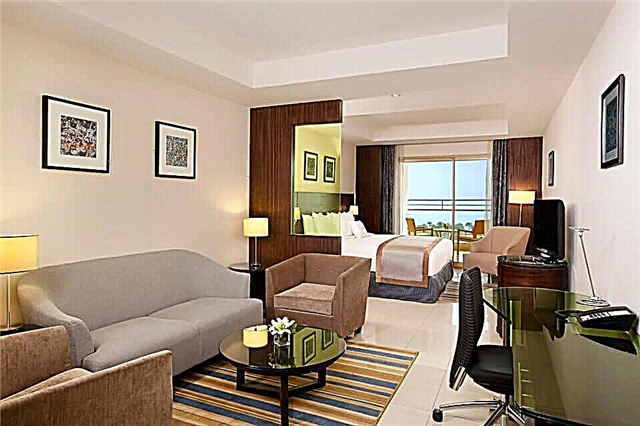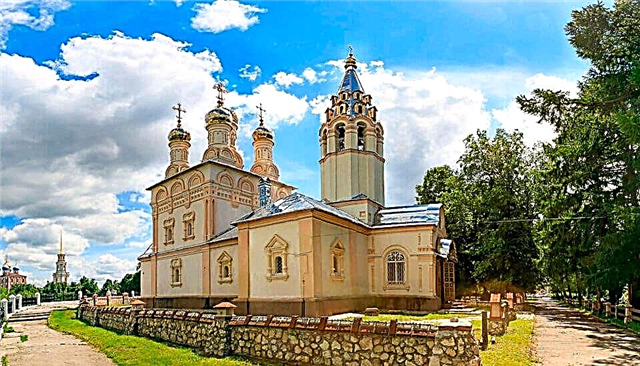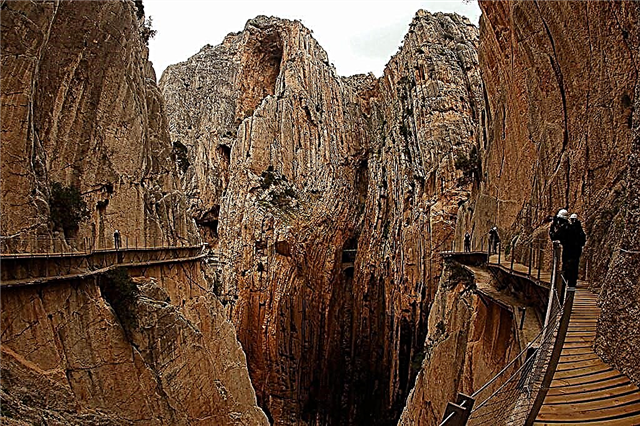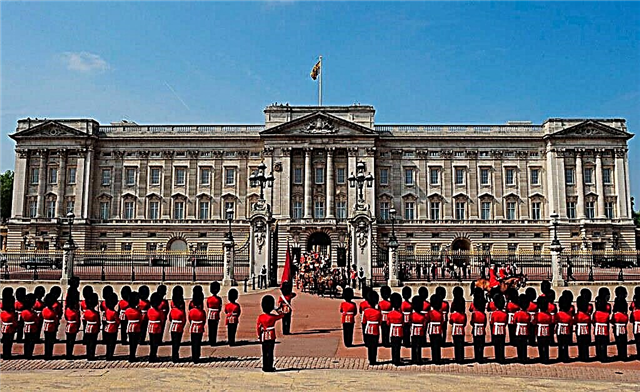There are not so many royal palaces left in the modern world. Buckingham Palace in London is one of them and probably the most famous.
History
In 1761, George III acquired Buckingham House (the former possession of the Duke of Buckingham) for his beloved wife Charlotte, in order to use it as a cozy family nest near St. James's Palace, where most of the court hearings were held. So Buckingham House (Buckingham House) gained fame as the “Queen's House”, and it was within its walls that fourteen of the fifteen children of George III were born.

George IV, after his coronation in 1820, ordered the reconstruction of the palace, transforming it into a “pied-à-terre” (“refuge”, “family refuge”). As reconstruction work progressed, towards the end of 1826, the king changed his mind. Having hired the architect John Nash, he decided to rebuild the house into a palace. Parliament approved a budget of one hundred and fifty thousand pounds, but the king demanded as much as three times more. Nash retained the main structure, doubling its size and adding rooms to the west side of the garden.
In terms of style, the exterior clearly showed the influence of French neoclassicism, approved by King George IV. Nash's remodeled rooms have remained largely unchanged over time. The north and south wings of Buckingham House were destroyed and re-erected at a larger size, with the Triumphal Arch, or Marble Arch, as the centerpiece of the extended courtyard. It was built to commemorate the landmark victories at Trafalgar and Waterloo.
By 1829, construction costs had risen to nearly half a million pounds. Nash's extravagance cost him the job, and after the death of George IV in 1830, his younger takeover, William IV, took over the architect Edward Blore to carry it through. In 1838, Queen Victoria ascended the throne, in 1840 she married Prince Albert, and their family life clearly “exposed” the significant shortcomings of Buckingham Palace. A noticeable disadvantage for the newlyweds was the practical absence of children's and guest rooms.
The only way out of this situation was to move the marble arch to Hyde Park and build a new wing. Blore added an attic to the main block of the palace and decorated it on the outside with marble friezes originally intended to decorate Nash's marble arch. The work was completed in 1847. Unfortunately, over time, the stone that Bloor used to build the east wing began to deteriorate, mainly due to the infamous London soot, and needed to be replaced.
In 1913, the decision was made to change the facade. Sir Aston Webb, who designed many of the local buildings, set to work on the design. He chose Portland limestone, which had been refurbished for a year before starting work. And after another 13 weeks, they spent dismantling the old masonry. The current look of Buckingham Palace was finally formed by 1911 as part of the Victoria Memorial program.
Central Park Hotel
London
Located less than 100 meters from Hyde Park

Hotel Edward Paddington
London
Minutes from Paddington Station and Hyde Park

DoubleTree by Hilton London - Docklands Riverside
London
Located on the embankment of the Thames

Park Plaza County Hall London
London
Just minutes from the banks of the Thames and the London Eye

Changing of the Guard

Immaculate guardsmen, drums and solemn orchestral music make the changing of the guard at Buckingham Palace one of the most luxurious and popular performances in London and the whole of Great Britain. It is a ceremony where the old guard hands over responsibility for guarding Buckingham and St James's palaces to the new guard. The guardsmen who were fortunate enough to participate in the ceremony are not only skillful soldiers, but also those who, in addition to their ordinary duties, specially prepare for this solemn event.
The ceremony itself is free, and you can watch it from two angles: either arrive at Buckingham Palace by about 10:15 am, or go for a trick and spend time at St. James's Palace, where you can see the beginning and end of the ceremony. Surprisingly, sometimes the orchestra performs not only solemn classics, but also relatively modern melodies, for example, the hits of the Beatles. The guards themselves are almost impossible to miss - their red uniforms and tall black caps made of bearskin are visible from afar.
An interesting fact - the hats of ordinary guardsmen are made from the fur of grizzly females, and those of high ranks are made from males, which is why the latter are more shiny and voluminous. Since the changing of the guard ceremony is optional, it can be celebrated due to bad weather conditions - you should take this into account when planning your trip. If everything is in order with the weather, the change is carried out daily in the summer months, and every other day in the winter.
Coca-Cola London Eye Ticket - £ 24.30
Tower of London and Royal Treasure Exhibition Ticket - £ 26.80
Tower Bridge Ticket - £ 9.80
Westminster Abbey entrance ticket and audio guide - £ 20
Madame Tussauds ticket - £ 29
St Paul's Cathedral Fast Track Ticket - £ 16
Skyscraper "Shard" - entrance ticket and champagne - £ 24.95
Rooms available for inspection

Since Buckingham Palace is the official residence of the British rulers, the number of rooms available for tourists is limited. You can visit the following ones:
- Throne room
- Gallery
- Ballroom
- Music room
- Green living room
- Blue living room
- White living room
Throne room

Architect John Nash took part in the decoration of theatrical scenes at one time, and the influence of this period is clearly visible in the design of the Throne Room - the spectacular arch and canopy over the royal armchairs look truly impressive. The color scheme of the decoration is majestic - rich red and gold tones prevail.
The centerpiece of the room is occupied by the royal armchairs of the monarchs, which were used for the coronation of the Queen and Duke of Edinburgh in 1953. It also houses the thrones from the coronation of George VI and Queen Elizabeth in 1937, and one made for Queen Victoria in 1837.
Green living room

The largest room on the ground floor, originally intended for the Duchess of Buckingham as a salon, but later, in early 1760, was remodeled specifically for Queen Charlotte. And then it was changed again for George IV. According to Nash's design, the ceiling was replaced with a new, richly decorated one, and the fireplace on the north side was destroyed, creating another doorway leading directly to the Throne Room.
Interior décor work took place in the early 1830s under the direction of Lord Duncannon, who arranged for the delivery of fine green silk, made in Ireland at the suggestion of the Queen of Adelaide. At the door leading to the Throne Room, you can see a Copley painting depicting the three youngest daughters of George III, among the furniture are Morel & Seddon armchairs and sofas.
Blue living room

Before the Ballroom appeared in Buckingham Palace in the 1850s, it was in the blue living room that large-scale celebrations took place. In particular, in May 1838, the first state ball was held here to celebrate the coronation of Queen Victoria. Blue shades prevail in decor and furniture elements (in particular, in the upholstery of chairs). There is also the famous “Table of Outstanding Commanders”, the marble top of which is decorated with images of ancient heroes.
White living room
A majestic space, decorated in white and gold colors. Many ancient exhibits are kept here.Take, for example, the table made by Jean-Henri Rieseneur himself or the beautiful gilded piano by Sebastian Erard, which he made especially for Queen Victoria. A notable detail of this living room is a secret door through which the queen herself loves to enter in order to surprise the gaping tourists.
Interesting Facts
- Buckingham Palace has 775 rooms. Of these, 19 are government, 52 are royal and guest rooms, 188 are staff bedrooms, 92 are offices and 78 are bathrooms.
- The building is 24 meters high, the length (front view) is 108 meters, and the depth is 120 meters.
- At one time, Buckingham Palace was visited by such prominent personalities as Wolfgang Amadeus Mozart (aged 7), Johann Strauss, Charles Dickens, J. F. Kennedy, Neil Armstrong, Mahatma Gandhi, Nelson Mandela and many others.
- More than 50,000 people visit the palace annually as guests at state banquets, lunches, dinners and garden receptions.
- In 2002, on the occasion of the Queen's anniversary, a magnificent concert was organized at Buckingham Palace, where Brian May performed the immortal “God Save the Queen” on the roof of the palace.
Opening hours and ticket prices
From July 21 to August 31, Buckingham Palace is open from 9:30 to 19:00 (the last ticket is sold at 17:15), and in September from 9:30 to 18:00 (the last ticket is until 16:15).
Cost:
- Adults - 24 euros
- Persons over 60 years old / students - 22 euros
- Persons under 17 - 13.50 euros
- Children under 5 years old - free
- Family ticket (two adults and three children under 17) - 61.50 euros
Where is it and how to get there
Address: Westminster, London SW1A 1AA
By tube: Victoria, Green Park, St James Park.
By bus: 11, 211, C1 and C10, stop “Buckingham Palace Road”.











